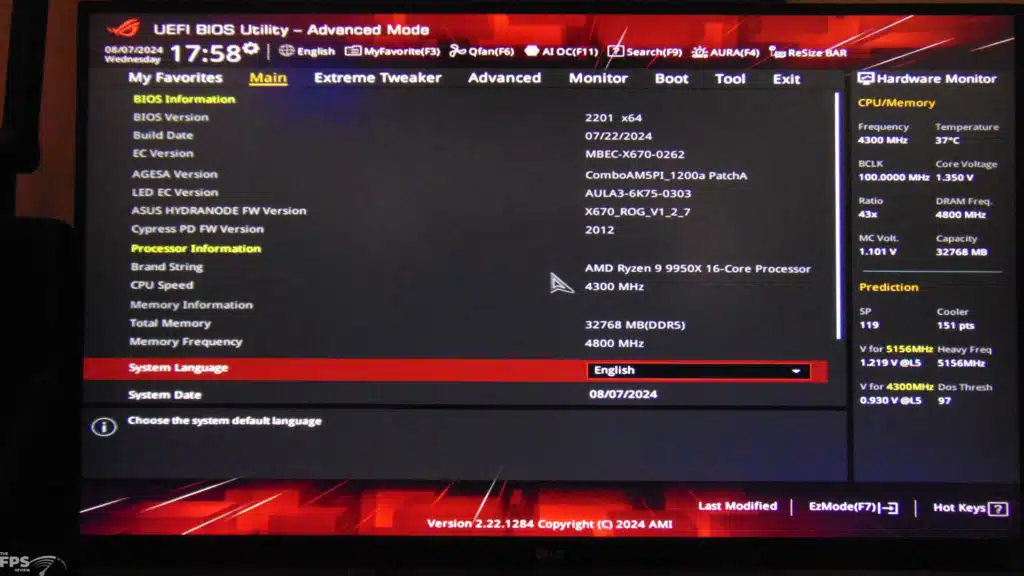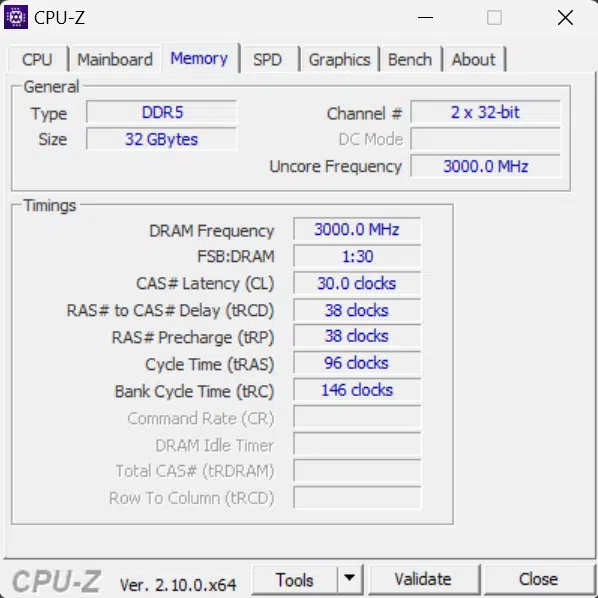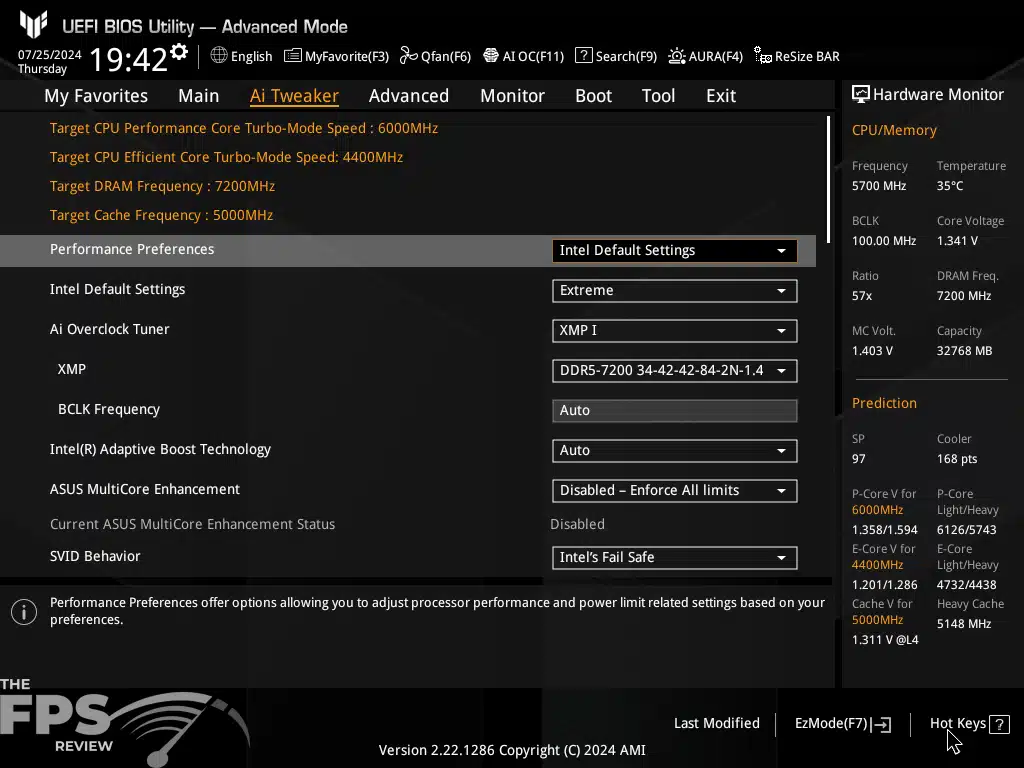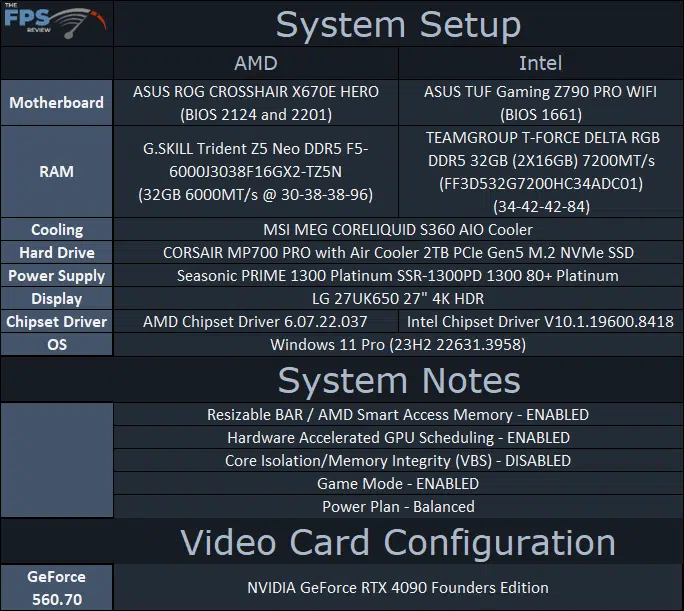Test Setup
Both the AMD platform, and Intel platform share the same AIO an MSI MEG Coreliquid S360 360mm AIO, and inside MSI Center the fan profile was set to “Gaming.” Both platforms share the same power supply, and Coarsair MP700 PRO 2TB PCIe Gen5 x4 NVMe SSD, and monitor. The same GeForce RTX 4090 Founders Edition was used on both platforms with driver GeForce 560.70. Each platform received a fresh install of Windows 11 Pro with all updates and a fresh install of all applications and games per platform, the same version of the OS was used. We do have Core Isolation/Memory Integrity DISABLED on each platform and CPU, and the Power Plan was set to “Balanced” for every CPU.
AMD Platform Setup

The AMD platform used BIOS 2124 dated 7/19/2024 for the ASUS ROG Crosshair Hero X670E motherboard for all Ryzen 7000 series CPUs, which is based on AGESA Combo AM5 PI 1.2.0.0a. This was the latest BIOS at the time of testing for all Ryzen 7000 series CPUs.
For the Ryzen 9000 series CPUs, we updated to an AMD-provided BIOS for this motherboard which was version 2201. This BIOS is still based on Combo AM5 PI 1.2.0.0a but adds a “PatchA” to the version. According to AMD PatchA has some tweaks specific to the Ryzen 9000 series 12-core and 16-core CPUs. Therefore, it would not have made any difference on Ryzen 7000 series CPUs, it’s still based on the same Combo AM5 PI 1.2.0.0a AGESA code, so everything is similar between them from a BIOS standpoint and AGESA standpoint.
We also installed the latest AMD Chipset drivers from AMD’s website which is version 6.07.22.037 dated 7/26/2024, this same version was used for every AM5 CPU tested. The RAM utilized on the AMD AM5 platform for all AM5 CPUs was 32GB of DDR5 at 6000MT/s CL30 set to EXPO I. This was the same on Ryzen 7000 and Ryzen 9000 CPUs.
*Note* – The FCLK (Infinity Fabric) was set to motherboard defaults with the “AUTO” setting in the BIOS after loading default settings. We confirmed that the FCLK frequency was running at 2100MHz for all of our testing. It was the same for each CPU. We opted to keep it on the default motherboard setting of “AUTO” to represent the ‘out-of-box’ experience with this motherboard/CPU/RAM combination at defaults. We always use default BIOS settings for testing, on all CPUs, with all motherboards, to keep it fair. All AMD CPUs were tested on this same motherboard and RAM kit.
Therefore, we are running AUTO:1:1 – which in effect is 2100:3000:3000 (FCLK/UCLK/MCLK) using EXPO I profile on this RAM, for 6000MT/s DDR5.



Intel Platform Setup
For the Intel platform, we updated our BIOS on the ASUS TUF Gaming Z790 PRO WIFI to version 1661 dated 7/10/2024. This is important because this BIOS supports new Intel Default Profiles of “Performance” and “Extreme” on the 14900K and runs at Intel Fail Safes with Multi-Core Enhancements from ASUS disabled. It also contains microcode 0x125 to ensure eTVB operates within Intel specifications. It does not, however, contain the new microcode fix for mismanagement of Voltage requests to the CPU.

This is, however, the latest BIOS we had access to at the time of testing, and is publically available. We are running the motherboard at the default BIOS settings on our CPUs. We are using the Intel Default Settings Profiles of “Extreme” and “Performance” that are available on the Intel Core i9-14900K CPU. The BIOS does run at “Intel Default Settings” under Performance Preferences and also sets SVID Behavior to “Intel’s Fail Safe” as well as “Disabling” ASUS MultiCore Enhancement.
We are running 32GB of DDR5 at 7200MT/s set to XMP I with 34-42-42-84-2T timings. We installed Intel Chipset Driver V10.1.19600.8418 dated 12/11/2023 from ASUS’s website for this motherboard. We also installed ME drivers, and other optional drivers for all supported hardware from ASUS’s website.

